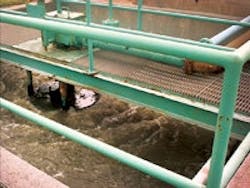About the author: Amy McIntosh is assistant editor for Water & Wastes Digest. McIntosh can be reached at [email protected] or 847.954.7966
The city of Merrill, Wis., is located in Lincoln County and has a population of approximately 10,000 residents. Nicknamed the City of Parks, Merrill is known for its scenic views and attractions along the Wisconsin and Prairie Rivers. Located along the Wisconsin River is the Merrill Wastewater Treatment Facility (WWTF).
In its 60-plus-year history, the plant has undergone few upgrades. The facility utilizes much of the same equipment that it did when it first opened, proving that aging equipment does not always diminish the quality of a plant’s operations.
At its inception in the early 1950s, the Merrill WWTF was constructed as a primary treatment plant. The plant remained unchanged until 1974, when the treatment process was upgraded to a secondary treatment system with conventional activated sludge and a chlorine disinfection process was added.
The plant underwent a major upgrade in the early 1990s. The facility’s wet oxidation process was eliminated and operators added anaerobic digesters, switched to a belt press system and integrated sludge storage facilities. In 1994, a phosphorous removal process was added.
Aside from some minor equipment upgrades, the plant’s infrastructure remains the same today.
The Process
The treatment process begins with a screen, followed by an aerated grit chamber with a grit classifier. Sludge settles in three primary rectangular settling tanks; from there, water is pumped to the aeration tanks.
Primary and waste-activated sludge are pumped to two clarifiers, a gravity thickener and anaerobic digesters. The sludge then is dewatered by belt presses and is stored on site or used on farm fields.
The Merrill WWTF is rated at 3.06 million gal per day (mgd), but according to Terence Vanden Heuvel, Merrill WWTF’s head operator, the plant averages slightly less than 1 mgd.
Meeting Requirements
In 2010, the state of Wisconsin revised its phosphorous limits to control the amount of toxic algae developing in the state’s waterways.
The Merrill WWTF currently is piloting a full-scale biological phosphorous removal program to maintain compliance with the new phosphorous requirements.
As part of the program, a baffle was added to the aeration tanks and an anoxic zone was created.
According to Vanden Heuvel, the plant has yet to see significant phosphorous removal, but the conditions continue to improve.
“It has paid off in other ways by helping us maintain alkalinity in our plant, thus reducing the need to add caustic, which has been a great cost savings,” Vanden Heuvel said.
Another major challenge the plant has faced in recent years has been high zinc levels in its sludge and effluent. The plant was reporting zinc levels of approximately 3,500 mg per kilogram of sludge.
To avoid action by the Wisconsin Department of Natural Resources, plant operators implemented an industrial monitoring program, reaching out to local zinc platers.
The program revealed a number of platers that had been discharging an excessive amount of the mineral.
“We have a good working relationship now and, at the last check of our sludge, we were down to 500 mg per kg,” Vanden Heuvel said. “So it’s been a very successful program.”
Planning for the Future
Although plant operations are running smoothly overall, Vanden Heuvel noted that the plant might undergo some upgrades in the next few years.
One improvement would be replacing the plant’s current chlorine gas disinfection and sodium bisulfite dechlorination process with a chlorine-free ultraviolet disinfection process.
“We’re also looking at upgrading our aeration blowers and the activated sludge part of our plant to more efficient blowers in the near future,” Vanden Heuvel said.
Ideally, plant operators also would like to be able to take septage directly to the digesters to produce more gas and integrate more waste-to-energy processes in the plant’s operations.
Until those upgrades are implemented, the facility will continue business as usual.
“We seem to be doing a fairly good job with a very old plant,” Vanden Heuvel said. “A lot of our tankage is 40 to 60 years old and we’re still maintaining it and keeping the plant going strong.”
Download: Here
